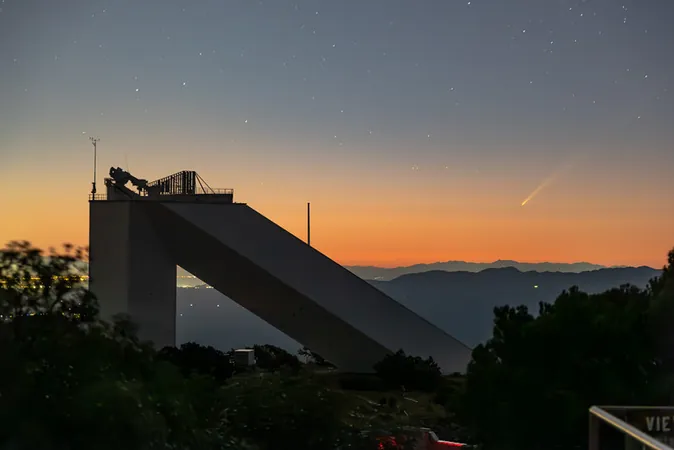
Stunning Global Views of Comet C/2023 A3 Tsuchinshan-ATLAS!
2024-10-31
Author: Ming
The dazzling Comet C/2023 A3 Tsuchinshan-ATLAS has captivated stargazers around the world as it survives perihelion, becoming a spectacular sight for northern hemisphere residents.
October has proven to be an unforgettable month for astronomy enthusiasts! Not only did we witness a powerful solar storm that illuminated the skies with auroras as far south as the Caribbean, but we were also treated to the stunning sight of Comet Tsuchinshan-ATLAS.
Discovered in early 2023, this mesmerizing comet is already being hailed as the best of 2024. It first caught the eyes of southern hemisphere observers back in September when it graced the dawn skies, signaling remarkable celestial events ahead.
A Close Encounter with the Sun
The highlight of the comet's journey was its perilous perihelion on September 27, when it trekked within 58.6 million kilometers of the Sun. At its brightest, the comet shone at nearly -5th magnitude! Distinctive features like a sharp spiky anti-tail became prominent, making it an unforgettable subject for astrophotography as it appeared to pierce the Sun in images captured by SOHO's LASCO C2 and C3 instruments.
In an exciting twist, the comet maintained a brightness of +1st magnitude for about a week as it graced the evening sky alongside Venus. During this phase, Comet T-ATLAS showcased a magnificent tail extending over a dozen degrees while its remarkable anti-tail maintained its sunward direction.
An Easily Accessible Celestial Phenomenon
Early October marked the comet's photogenic peak, becoming a perfect target against the nocturnal canvas. Remarkably, even those with just a smartphone could capture decent images in night mode, thanks to its brightness. Light pollution posed little obstacle, as astonishing photos emerged from vibrant urban centers like Los Angeles, eclipsing any prior expectations of viewing difficulties.
Reflecting on past encounters, it’s fascinating to consider that during the last prominent comet appearance (C/1995 O1 Hale-Bopp in 1997), digital photography was still a novelty. One can only imagine the spectacular images we could capture of an equally brilliant comet today!
Astrophotographer Hisayoshi Kato shared his experience, stating, “I drove north for more than three hours and reached the seashore facing the Sea of Japan after sunset. Fortunately, the sky was clear, allowing me to enjoy the breathtaking view of the comet sinking into the Sea of Japan over the weekend.”
Anticipation for the Next 'Great Comet'
Astronomers and enthusiasts alike are buzzing with excitement for the next 'Comet of the Century.' Presently, Comet T-ATLAS remains a captivating binocular object at +6th magnitude within the Ophiuchus constellation, continuing its journey on a nearly quarter-of-a-million-year orbit. However, a second sungrazer counterpart did not emerge as anticipated, with Comet C/2024 S1 ATLAS concluding its brief existence earlier this month.
Renowned astronomer Gianluca Masi summed up the sentiments of many sky-watchers, stating, “We’ve witnessed extraordinary evidence of the nightly sky's magnificence. Comet C/2023 A3 Tsuchinshan-ATLAS is still putting on a stellar performance, reminding us that the universe is full of emotions and wonders for those who often gaze up at the stars.”
Looking ahead, we have another opportunity to catch a breathtaking comet with the anticipated arrival of C/2024 G3 ATLAS in January 2025. This potential comet promises to reach brightness of -1st magnitude or even brighter as it approaches perihelion. Stay tuned for this astronomical marvel!



 Brasil (PT)
Brasil (PT)
 Canada (EN)
Canada (EN)
 Chile (ES)
Chile (ES)
 España (ES)
España (ES)
 France (FR)
France (FR)
 Hong Kong (EN)
Hong Kong (EN)
 Italia (IT)
Italia (IT)
 日本 (JA)
日本 (JA)
 Magyarország (HU)
Magyarország (HU)
 Norge (NO)
Norge (NO)
 Polska (PL)
Polska (PL)
 Schweiz (DE)
Schweiz (DE)
 Singapore (EN)
Singapore (EN)
 Sverige (SV)
Sverige (SV)
 Suomi (FI)
Suomi (FI)
 Türkiye (TR)
Türkiye (TR)